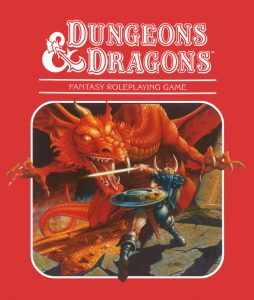Roll With It: How Playing Dungeons & Dragons Can Improve Your Writing
Micaela Pryor//Blog Writer
Dungeons & Dragons has exploded into popular culture in the past few years. If you’ve seen Stranger Things, or any of the dozens of podcasts and livestreams dedicated to playing, then you’re likely aware of the fantasy roleplaying game. Speaking from experience, it’s a wonderfully fun activity for groups of friends to flex their creativity and improv skills in a magical sword-and-sorcery world. Over the two and a half years I’ve played D&D, I’ve noticed that the game secretly holds a treasure trove of lessons applicable to creative writing. The benefits of frequent exposure to D&D are numerous, but here are a few tips and testimonies to implement into your writing process.
 Step one of D&D is to piece together a playable character from the race, class, and background choices given in the Player’s Handbook. For example, you could be an elf wizard with a background in criminal organizations, or a dwarf monk who grew up in a holy temple. It’s simple enough, but the real challenge lies in making the character come to life in-game. The process of coming up with a character to play is not dissimilar to writing a fictional character, even one outside a fantasy universe. In both fiction and D&D, your character needs to have an individual personality, backstory, and voice. D&D requires you, the player, to speak in this character’s voice and work to maintain their personal beliefs amidst a group of adventurers. Writing a fictional character’s dialogue and narration can prove difficult if their voice is bland and unrecognizable. Avid D&D player Kyle Madigan acknowledges the similarities adventurers have with original fictional characters: “Every character, but especially the main character, has goals and a reason why they’re doing what they’re doing. Every action they take should somehow be furthering along the journey they have been set on. This can help inform, for example, dialogues between two characters. What are their goals? Why are they having this conversation? What are they aiming for, and what do they expect?” Working off your fellow players will help you pinpoint the ways a character stands out from a group. It’s a great lesson in recognizing a character’s unshakable core — the thing that makes them both consistent and unique.
Step one of D&D is to piece together a playable character from the race, class, and background choices given in the Player’s Handbook. For example, you could be an elf wizard with a background in criminal organizations, or a dwarf monk who grew up in a holy temple. It’s simple enough, but the real challenge lies in making the character come to life in-game. The process of coming up with a character to play is not dissimilar to writing a fictional character, even one outside a fantasy universe. In both fiction and D&D, your character needs to have an individual personality, backstory, and voice. D&D requires you, the player, to speak in this character’s voice and work to maintain their personal beliefs amidst a group of adventurers. Writing a fictional character’s dialogue and narration can prove difficult if their voice is bland and unrecognizable. Avid D&D player Kyle Madigan acknowledges the similarities adventurers have with original fictional characters: “Every character, but especially the main character, has goals and a reason why they’re doing what they’re doing. Every action they take should somehow be furthering along the journey they have been set on. This can help inform, for example, dialogues between two characters. What are their goals? Why are they having this conversation? What are they aiming for, and what do they expect?” Working off your fellow players will help you pinpoint the ways a character stands out from a group. It’s a great lesson in recognizing a character’s unshakable core — the thing that makes them both consistent and unique.
Playing Dungeons & Dragons also reminded me of the importance of an active main character. Passive heroes can be the death of a compelling story. An author’s first draft might have the main character bumping from plot point to plot point, with little input from the character themselves. The plot happens to them instead of because of them, and the reader is bored and frustrated by their apathy and powerlessness. Dungeons & Dragons is a story-based game, but without player choices and decisions, the story would never unfold. “Challenging my problem-solving abilities has really improved my writing. As a player, if I encounter a giant chasm that I need to cross, I don’t just give up and go home. That would make for a boring narrative. Instead, I start testing as many ideas as possible. What if I climbed the rock wall? What if I swung across on a rope? The same goes for writing,” says Allison Rassmann, a player of many colorful and gung-ho D&D characters. D&D puts the power of story in the hands of the characters, as every author should do in their writing. When writing, look at how much your character’s decisions impact the plot of the story. If major discoveries often fall into their lap, try a second draft that has them actively seeking out information and reacting in ways consistent with their unshakable core beliefs. They’ll go from the backseat of the narrative to the driver of their own story.
 On the other side of the screen, running a game as a Dungeon Master (DM) can prove to be an exceptionally demanding task. The DM narrates a story, and the players navigate their way through the puzzles, quests, traps, monsters, etc. laid out before them. DMing requires an intriguing premise, a host of NPCs to interact with, and just the right clues to get your players moving in the direction you want without forcing them into a rigid plot. “In D&D and as a DM, you don’t have control of the plot because you don’t have control of the player characters. You can’t force your player characters to investigate the creepy mansion at the top of the hill just because you want them to, instead you must intrigue them, make the players want to, or have to, investigate it. Having to understand what would motivate a player character into making decisions that drive conflict and tension is a skill that easily translates into fiction writing,” says Sophia Uy, who has been running her campaign in weekly sessions for over a year. Crafting a storyline for others to participate in can help you recognize the construction of a compelling narrative, which is necessary both for your players and your audience. The elements of story that hook a player will also hook a reader, whether the plan is to solve a mystery, escort a treasure load, delve into a dungeon, or slay a dragon. Mrinalini Basu, who has played D&D since high school, has gleaned crucial techniques in effective story delivery: “The most useful part of the game has been learning how to communicate a story. Storytelling is integral to a game, and having to describe a scene clearly and viscerally to my players is what has translated most into my writing over the last two years.” Running a game of D&D is hard work, but it forces you to look at the bones of what makes a compelling story and convey that story in accessible terms.
On the other side of the screen, running a game as a Dungeon Master (DM) can prove to be an exceptionally demanding task. The DM narrates a story, and the players navigate their way through the puzzles, quests, traps, monsters, etc. laid out before them. DMing requires an intriguing premise, a host of NPCs to interact with, and just the right clues to get your players moving in the direction you want without forcing them into a rigid plot. “In D&D and as a DM, you don’t have control of the plot because you don’t have control of the player characters. You can’t force your player characters to investigate the creepy mansion at the top of the hill just because you want them to, instead you must intrigue them, make the players want to, or have to, investigate it. Having to understand what would motivate a player character into making decisions that drive conflict and tension is a skill that easily translates into fiction writing,” says Sophia Uy, who has been running her campaign in weekly sessions for over a year. Crafting a storyline for others to participate in can help you recognize the construction of a compelling narrative, which is necessary both for your players and your audience. The elements of story that hook a player will also hook a reader, whether the plan is to solve a mystery, escort a treasure load, delve into a dungeon, or slay a dragon. Mrinalini Basu, who has played D&D since high school, has gleaned crucial techniques in effective story delivery: “The most useful part of the game has been learning how to communicate a story. Storytelling is integral to a game, and having to describe a scene clearly and viscerally to my players is what has translated most into my writing over the last two years.” Running a game of D&D is hard work, but it forces you to look at the bones of what makes a compelling story and convey that story in accessible terms.
As beneficial as structure is to a campaign, and to a fictional work in progress, there is an oft-overlooked aspect of longform writing that is imperative to improvement: making it up as you go. Improvisation is a key component to DMing. Your players are guaranteed to do something you weren’t expecting, and very quickly a carefully planned storyline can derail into a wholly unanticipated adventure. Don’t let that scare you from the game, though, because chaos is just as inspirational as structure. Having extensive worldbuilding laid out before diving into the story can be helpful, but at a certain point it can bog down creativity and force your writing into rigidity. Let yourself break a few of the rules, just to see what would happen. See what directions a narrative can take when a character makes a rash decision. Overall, try to surprise yourself in your own story. Making things up as you go may mean editing out a lot later, but it also helps fend off stagnation and keeps the reader on their toes.
Dungeons & Dragons is more than just a game, it’s a vehicle for collaborative storytelling exercises. It’s a chance to stretch your creative thinking skills and look at stories from different angles. There are many more lessons to uncover in D&D, but remember that you can only benefit from them if you round up a group and play the game yourself. As you play, keep an eye out for the many ways character creation, roleplaying, and DMing can level up your creative writing. Most importantly, have a great adventure.
